Explore the transformative canvas of Pablo Picasso through our curated selection of his Top 10 famous paintings. Dive into the genius of Cubism, the emotion of the Blue Period, and the innovation that shaped modern art. This article offers a visual feast from ‘The Old Guitarist’ to ‘Guernica,’ perfect for art enthusiasts and history buffs alike. Discover the stories behind each masterpiece and Picasso’s enduring legacy in this insightful tribute to one of art’s greatest pioneers.
Table of Contents
Introduction to the Genius of Pablo Picasso
Pablo Picasso stands as a titan in the world of art, his name synonymous with the revolutionary movements that reshaped the visual arts landscape in the 20th century. Known for his prolific output and pioneering spirit, Picasso co-founded Cubism, dabbled in various art forms, and produced an astonishing array of works spanning over seven decades. His journey through periods of blue, rose, African influence, and Cubism marks an evolution that not only defined his career but also left an indelible mark on modern art. This article embarks on a visual journey through Picasso’s Top 10 famous paintings, revealing the depth, innovation, and emotional range of a master whose works continue to captivate and inspire.
The Blue Period: Depths of Emotion and Monochromatic Mastery
1. The Old Guitarist, 1903
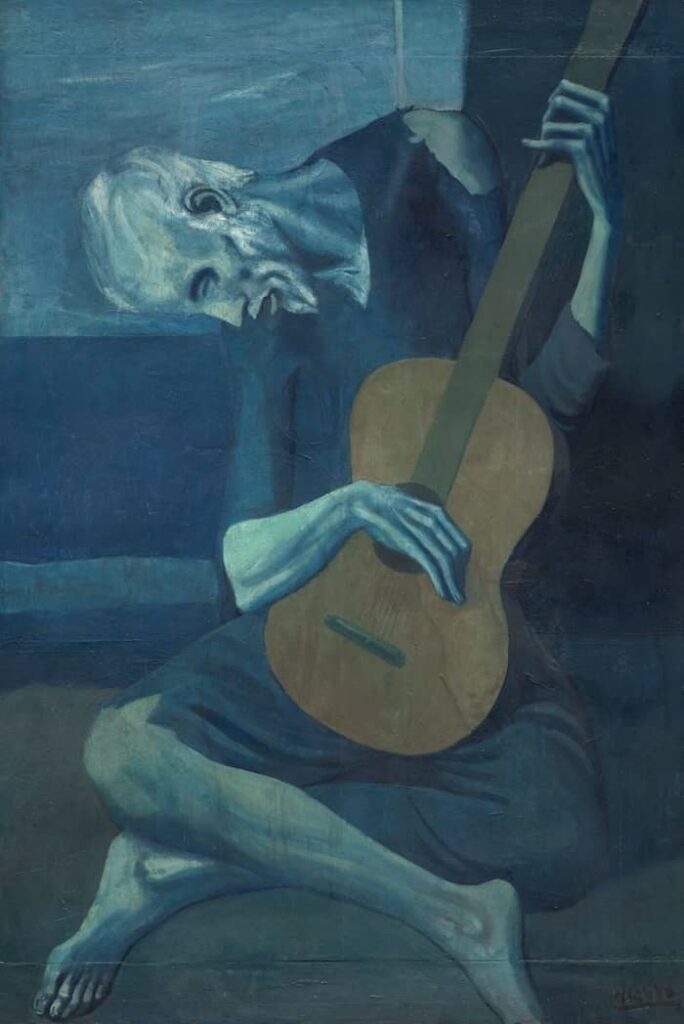
Pablo Picasso’s Blue Period, spanning from 1901 to 1904, is a testament to the artist’s profound ability to convey deep emotional and psychological states. Characterized by monochromatic shades of blue and blue-green, this period reflects Picasso’s own emotional turmoil and societal observations. “The Old Guitarist,” one of the most iconic pieces from this era, encapsulates the essence of despair and solitude, portraying an aged musician engrossed in his instrument. This painting, alongside others from the Blue Period, offers a window into Picasso’s soul, marking a significant phase in his artistic journey where personal grief translated into groundbreaking artistry.
2. Science and Charity, 1897
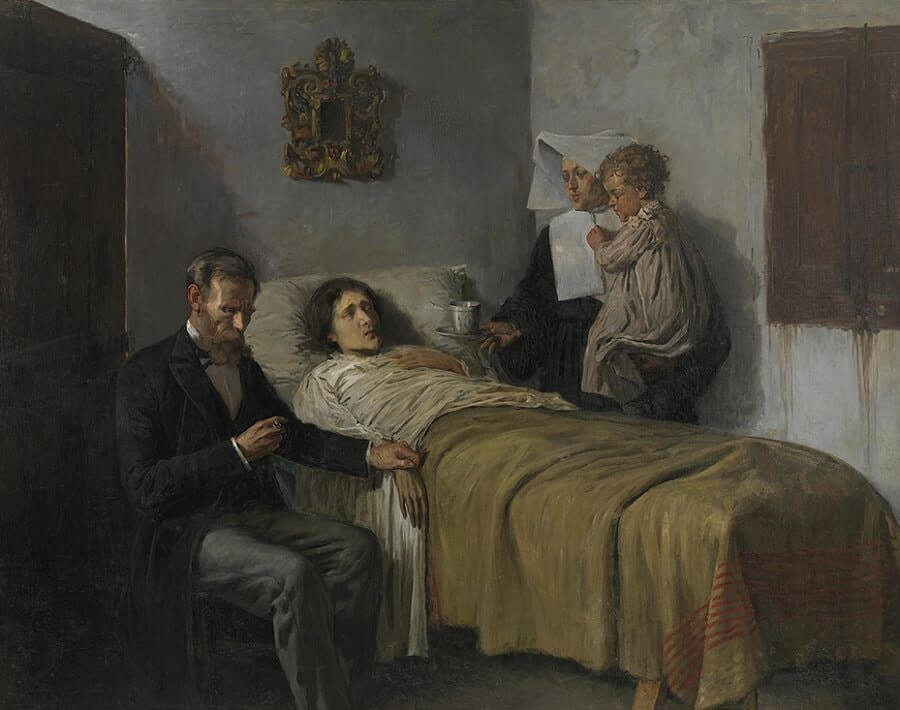
Science and Charity is Picasso’s one of the early masterpieces, this painting delves into themes of human compassion and the juxtaposition of science and religion, showcasing his skill in realism during his formative years. It provides insight into the young Picasso’s perspective on societal roles and the human condition.
The Rose Period: A Shift to Warmth and Circus Life
3. Saltimbanques (The Family of Saltimbanques), 1905

Transitioning from the somber Blue Period, Picasso’s Rose Period (1904-1906) showcases a marked shift to warmer orange and pink tones, reflecting a more optimistic phase of his life. The painting “Family of Saltimbanques” stands out as a hallmark of this era, depicting itinerant circus performers—a theme of personal interest to Picasso. This period’s works, characterized by their exploration of companionship amidst isolation, reveal Picasso’s fascination with the transient lives of circus folk, offering a unique blend of warmth, complexity, and humanity.
African-Influenced Period: A Radical Departure
4. Les Demoiselles d’Avignon, 1907
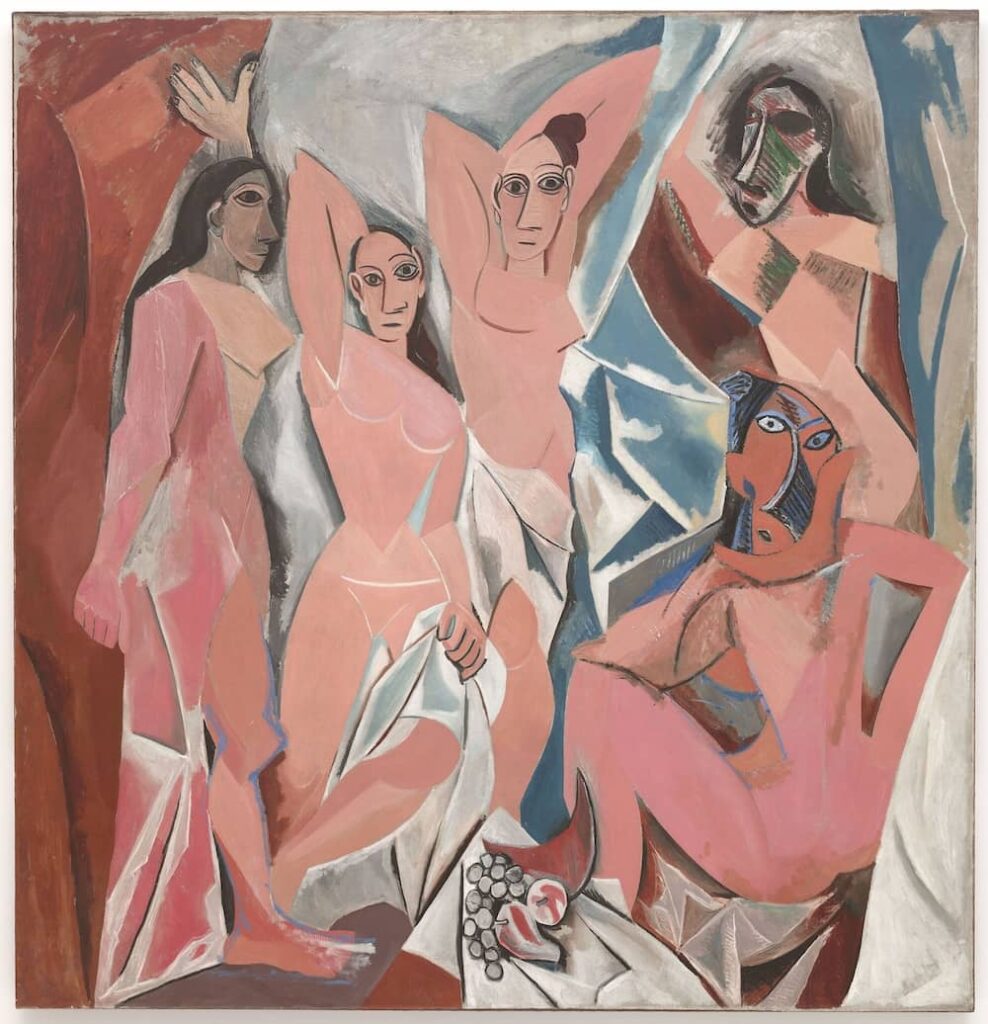
During the African-Influenced Period (1907-1909), Picasso’s work underwent a radical transformation, drawing inspiration from African art and sculptures. This period is best exemplified by “Les Demoiselles d’Avignon,” a masterpiece that challenges traditional perspectives and marks the genesis of Cubism. The painting’s striking departure from conventional forms and its embrace of abstract and geometric shapes underscore Picasso’s innovative approach to representation, setting the stage for his future explorations in Cubism and solidifying his status as a trailblazer in modern art.
Cubism: Breaking the Mold
5. The Reservoir, 1909
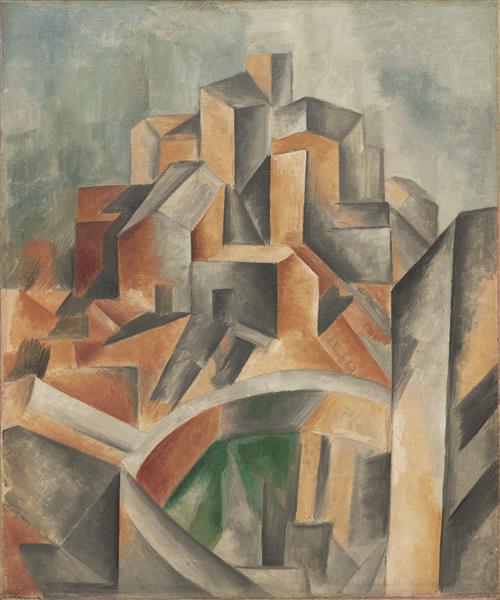
Picasso’s foray into Cubism, notably from 1909 onwards, revolutionized the art world. This era is characterized by fragmented forms and a departure from traditional perspectives, aiming to depict subjects from multiple viewpoints simultaneously. “The Reservoir, Horta de Ebro” and “Girl with a Mandolin (Fanny Tellier)” are quintessential examples, showcasing how Picasso dissected and reassembled forms in abstract, geometric shapes. This innovative approach not only marked a pivotal point in Picasso’s career but also laid the groundwork for modern abstract art.
6. Girl with a Mandolin, 1910
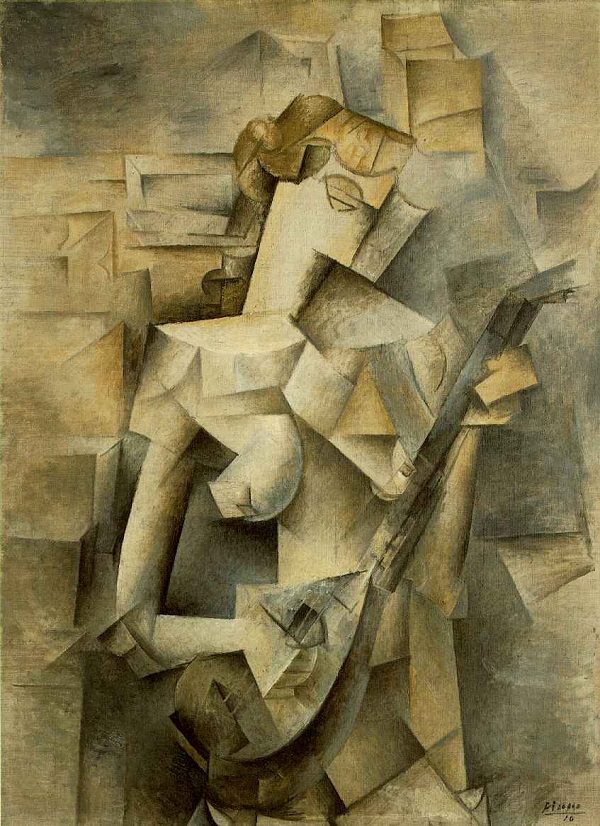
“Girl with a Mandolin” (1910) is one of Picasso’s more subdued yet intricate explorations of Cubism, where he dismantles and reassembles both form and perspective. The painting shows a figure cradling a mandolin, their form a collage of muted, interlocking shapes that blend into the surrounding space. This work is a profound expression of Cubism’s core intent—to portray the subject from multiple angles and to merge the background with the foreground, challenging the viewer’s perception of depth and dimension.
7. Three Musicians, 1921

“Three Musicians”: A vibrant example of Picasso’s Synthetic Cubism phase, this painting features a trio of musicians in a complex, colorful composition. It reflects Picasso’s interest in abstract forms and his ability to convey harmony and rhythm through geometric shapes, adding depth to the narrative of his cubist explorations.
Classicism and Surrealism: A Return and a Reimagining
8. The Dream (Le Rêve), 1932

Picasso’s journey into Classicism and Surrealism, particularly highlighted in works like “The Dream,” demonstrates his versatility and ability to adapt to and reinvent various styles. This phase showcases a blend of traditional forms with the fantastical elements of Surrealism, offering a window into Picasso’s complex psyche and his ongoing exploration of the human condition.
The War Years: A Testament to Tragedy
8. Guernica, 1937

During the War Years, Picasso’s art took a political turn, most notably with “Guernica,” a powerful response to the bombing of a Basque town during the Spanish Civil War. This masterpiece encapsulates the horror and chaos of war, serving as a universal symbol of tragedy and a plea for peace. Through “Guernica,” Picasso demonstrates the power of art as a tool for social commentary, solidifying his role not just as an artist but as a conscientious observer of his time.
Later Works: Reflecting on a Lifetime
9. Le matador (The Matador), 1958
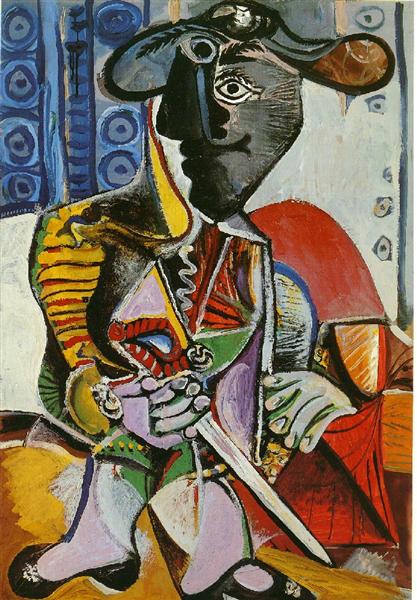
In his later years, Picasso continued to innovate and reflect, evident in works like “The Matador” and “Jacqueline with Flowers.” These pieces showcase a blend of vibrant colors, bold lines, and emotional depth, highlighting his lifelong fascination with Spanish culture and his deep affection for his muses. Picasso’s late style merges various elements from his earlier periods, encapsulating the breadth of his artistic exploration and his unyielding passion for creation until the end of his days.
10. Jacqueline with flowers, 1954
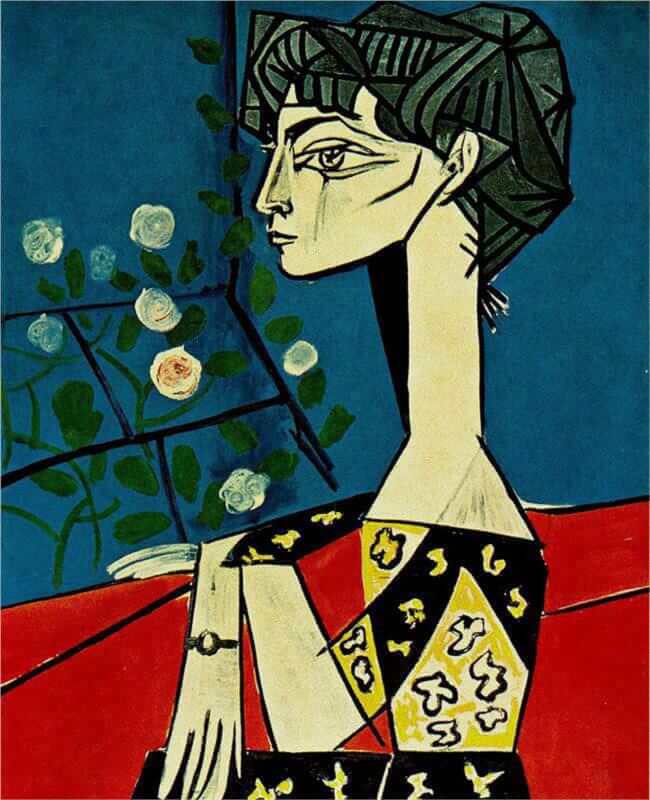
“Jacqueline with Flowers” is an intimate portrait of Picasso’s last wife, Jacqueline Roque, which reflects her enduring influence on his work. Her stylized, elongated form and the serene expression on her face, accompanied by the vibrant blooms beside her, symbolize the beauty and calm she brought to Picasso’s later life. The use of bold, flat colors alongside the complex patterns of her attire illustrates the fusion of simplicity and complexity that defines this late period of Picasso’s artistic journey.
Legacy and Influence: Picasso’s Enduring Impact
Pablo Picasso’s body of work not only transformed the course of modern art but also continues to inspire and challenge artists today. His innovative approaches to painting, sculpture, and printmaking opened new avenues for creative expression, influencing countless movements and individual artists. Picasso’s legacy is a testament to the enduring power of art to reflect and shape human experience, proving that his influence extends far beyond the confines of galleries and museums.
Conclusion: Picasso’s Indelible Mark on the Art World
Pablo Picasso’s journey through various artistic periods and styles not only showcases his unparalleled versatility and creativity but also his profound impact on the art world. From the emotional depth of the Blue Period to the groundbreaking Cubism and beyond, Picasso’s works continue to fascinate and inspire. His legacy is a rich tapestry of innovation, challenging future generations to see the world through a lens of endless possibility.
FAQs
Who was Pablo Picasso?
Pablo Picasso was a Spanish painter, sculptor, printmaker, and one of the most influential artists of the 20th century. He is best known for co-founding the Cubist movement and for the wide variety of styles that he helped develop and explore.
What is Picasso’s most famous piece?
While Picasso has many renowned works, “Guernica” is often cited as his most famous painting. It is a powerful political statement, painted as an immediate reaction to the Nazi’s devastating casual bombing practice on the Basque town of Guernica during the Spanish Civil War.
Why is ‘The Old Guitarist’ considered a significant work in Picasso’s career?
‘The Old Guitarist’ is significant because it was created during Picasso’s Blue Period, which was a time of great personal turmoil and financial struggle. The painting’s monochromatic blue palette and the subject’s expression evoke the themes of poverty and human suffering.
What distinguishes Picasso’s Rose Period?
Picasso’s Rose Period is characterized by a lighter palette and a more optimistic mood than the preceding Blue Period. It often depicted circus scenes and had elements of warmth, in stark contrast to the somber tones of his earlier works.
How did ‘Les Demoiselles d’Avignon’ impact modern art?
‘Les Demoiselles d’Avignon’ is considered a seminal work in the development of both Cubism and modern art. Its radical approach to form and perspective was a break from traditional representation and laid the groundwork for a new direction in artistic expression.
Can you explain what Cubism is?
Cubism is an artistic movement that was co-founded by Picasso and Georges Braque, characterized by fragmented objects and multiple perspectives within the same space to represent three dimensions on a flat canvas.
How many paintings did Picasso create?
Picasso was incredibly prolific throughout his long career, creating an estimated 50,000 artworks, including paintings, drawings, sculptures, ceramics, prints, tapestries, and rugs.
What is so special about ‘Girl with a Mandolin’?
‘Girl with a Mandolin’ is celebrated for its innovative approach to form and its role in the evolution of Cubism. It shows Picasso’s shift from representational to abstract depiction, signaling a more radical phase of his Cubism.
Why did Picasso paint ‘Guernica’?
Picasso painted ‘Guernica’ as a reaction to the bombing of the Basque town of Guernica by Nazi German and Italian fascist forces during the Spanish Civil War. It is a poignant anti-war statement and a depiction of the tragedies of war and the suffering it inflicts upon individuals.
Are Picasso’s paintings displayed in museums?
Yes, Picasso’s paintings are displayed in museums all around the world. Some of the most notable museums include the Museo Picasso in Barcelona, the Picasso Museum in Paris, and the Reina Sofia museum in Madrid, where ‘Guernica’ is housed.
